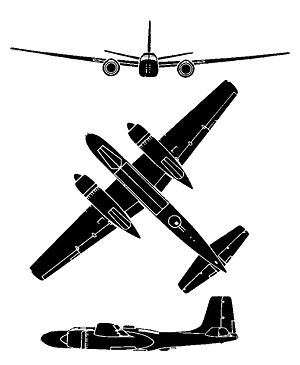PENDING SALE
1944 Factory TB-26C
"Fire Eater" the star of the Spielberg movie "Always"
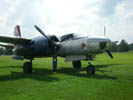 |
N4818E#44-35371
For history and more info on this aircraft, please see our newsletter page. |
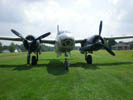 |
|
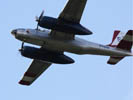 |
|
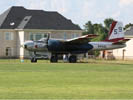 |
See this incredible bird in action in this clip from the movie, "Always."
The following courtesy of Wikipedia.
Specifications (A-26B-15-DL Invader)
|
Data from McDonnell Douglas Aircraft Since 1920 |
General characteristics
- Crew: 3
- Length: 50 ft 0 in (15.24 m)
- Wingspan: 70 ft 0 in (21.34 m)
- Weight: 18 ft 3 in (5.64 m)
- Wing area: 540 ft² (50 m²)
- Empty weight: 22,850 lb (10,365 kg)
- Loaded weight: 27,600 lb (12,519 kg)
- Max takeoff weight: 35,000 lb (15,900 kg)
- Powerplant: 2× Pratt & Whitney R-2800-27 "Double Wasp" radials, 2,000 hp (1,500 kW) each
Performance
- Maximum speed: 355 mph (308 kn, 570 km/h)
- Range: 1,400 mi (1,200 nmi, 2,300 km)
- Service ceiling: 22,000 ft (6,700 m)
- Rate of climb: 1,250 ft/min (6.4 m/s)
- Wing loading: 51 lb/ft² (250 kg/m²)
- Power/mass: 0.145 hp/lb (108 W/kg)
Variants
Douglas/US Military Variants
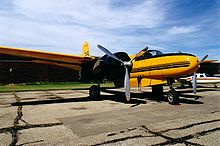
Aerial firefighting Douglas A-26C Invader owned by Air Spray (1967) Ltd at Red Deer, Alberta, 2000
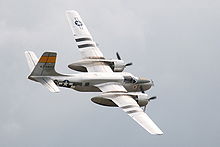
"A-26B" (44-34602), registered N167F at Duxford, UK July 2008 (note windows and airstair door from conversion as Rock Island Monarch)
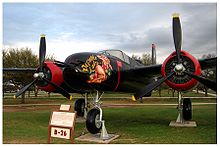
A-26C-50-DT 44-35918 marked as A-26B 434287 "Versatile Lady" USAF History and Traditions Museum
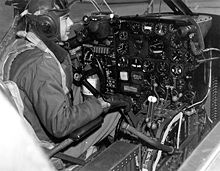
A-26 cockpit interior
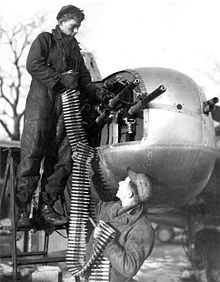
Re-loading machine guns on an A-26B with a six-gun nose
The large majority of the A-26/B-26 Invader's production run of 2,452 were early A-26Bs and A-26Cs.
XA-26
Serial no. 41-19504 served as the prototype for the series; initially flown with dummy armament
XA-26A
Serial no. 41-19505 served as a prototype night fighter with a crew of two - pilot plus radar-operator/gunner
XA-26B
Serial no. 41-19588 was a prototype "solid-nosed" attack variant with crew of three: pilot, gun loader/navigator (in front cockpit) plus gunner in rear, and carrying a forward firing 75 mm (2.75 in) cannon.
A-26B
Attack bomber with solid nose carrying six or eight 0.50 in (12.7 mm) machine guns. Production totals: 1,355 A-26Bs were built and delivered, 205 at Tulsa, Oklahoma (A-26B-5-DT to A-26B-25-DT) plus 1,150 at Long Beach, California (A-26B-1-DL to A-26B-66-DL). About 24 more airframes were built at Long Beach but not delivered to USAAF, some of those later sold to other civil and military customers. A-26B was redesignated B-26B with USAF in 1948.
TB-26B
Unarmed variant converted from B-26B for training purposes.
VB-26B
Unarmed variant converted from B-26B for administrative purposes.
A-26C
Attack bomber. Production totals: 1,091 A-26Cs were built and delivered, five at Long Beach, California (A-26C-1-DL and A-26C-2-DL) plus 1,086 at Tulsa, Oklahoma (A-26C-16-DT to A-26B-55-DT). About 53 more airframes were built at Tulsa but not delivered to USAAF, some of those later sold to other civil and military customers. A-26C was redesignated B-26C with USAF in 1948.
RB-26C
Unarmed photo reconnaissance variant converted from B-26C; it carried cameras and flash flares for night photography. Designated FA-26C prior to 1962.
TB-26C
Unarmed variant converted from B-26C for training purposes.
XA-26D
Serial no. 44-34776 prototype for the proposed A-26D attack bomber with uprated Chevrolet manufactured R-2800-83 engines, and late model A-26B armament of eight 0.50 in (12.7 mm) machine guns in solid nose and six 0.50 in (12.7 mm) guns in the wing[35]; series of 750 A-26Ds was cancelled after V-J Day.
XA-26E
Serial no. 44-25563 prototype for the A-26E attack bomber. As with the XA-26D but with an A-26C-type glass nose;[35] a contract for 2,150 A-26E-DTs was cancelled following V-J Day.
XA-26F
Serial no. 44-34586 prototype for a high-speed A-26F powered by two 2,100 hp (1,600 kW) R-2800-83 engines driving four-bladed propellers with a 1,600 lbf (7.1 kN) s.t. General Electric J31 turbojet installed in the rear fuselage. The prototype reached a top speed of 435 mph (700 km/h) but the series was cancelled as performance gains were not sufficient.
A-26Z
Unofficial designation for a proposed postwar production version of the A-26. It was to have a more powerful version of the Pratt & Whitney R-2800 radial engine and was to be fitted with such features as a raised pilot's cockpit canopy, an improved cockpit arrangement and wingtip drop tanks. If produced, the unglazed nose version would have been designated A-26G and the glazed nose version A-26H. However, in October 1945, the USAAF concluded that there were enough A-26 aircraft to meet postwar needs, consequently, the "A-26Z" version was not produced.
JD-1
US Navy version with one A-26B (44-34217) and one A-26C (44-35467) redesignated during World War II, postwar, 150 surplus A-26s for use by land-based utility squadrons as target tugs and later, drone directors (designated JD-1D) and general utility aircraft. In 1962, the JD-1 and JD-1D were redesignated UB-26J and DB-26J respectively.
YB-26K
On Mark Engineering prototype for refurbished attack bomber; modifications included rebuilt, strengthened wings, enlarged tail assembly, new R-2800-103W engines with reversible propellers/propeller spinners, dual controls, wingtip tanks, newer avionics and increased hardpoint/armament enhancements.
B-26K
On Mark Engineering conversions of 40 B-26Bs or TB-26Bs with two B-26Cs and a single JB-26C; changes included fitting of 2,500 hp (1,900 kW) R-2800-52W engines with no propeller spinners and the six wing guns deleted. During operations in Vietnam, in May 1966, the aircraft were reassigned the old attack designation of A-26A.[36] The A-26As were retired in 1969 when they had reached the safe limits of allotted flying time.
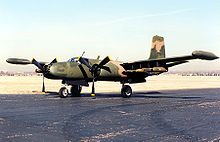
B-26K/A-26A Counter Invader (64-17675)
RB-26L
Two RB-26Cs (44-34718 and 44-35782) modified for night photography missions.
B-26N
Unofficial designation applied to B-26s operated by the French Air Force (Armée de l'air) in Algeria as night fighters. These aircraft were modified B-26Cs fitted with AI Mk X radar taken from obsolete Meteor NF 11 night fighters, two underwing gun packs each with two 0.50 in (12.7 mm) M2 Browning machine guns and SNEB rocket pods.
